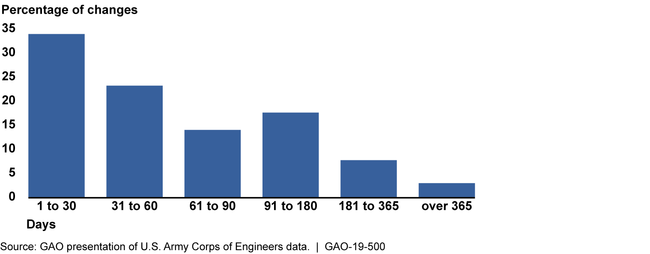Federal Construction: Army Corps of Engineers and GSA Need to Improve Data on Contract Changes
Fast Facts
The government spends billions annually on construction projects. Contract changes, common on such projects, can delay payments and create challenges for contractors, particularly small businesses.
We looked at construction contract changes at two agencies with large construction budgets: the U.S. Army Corps of Engineers and the General Services Administration. We found neither agency regularly tracks how long it takes to process contract changes, which makes it more difficult for them to identify and respond to problems.
We recommended these agencies each develop a strategy to monitor how long construction contract changes take.

A hardhat, office blueprints, and assorted office supplies on a desk.
Highlights
What GAO Found
Multiple factors affect the time it takes to finalize a construction contract change. For example, preparing cost estimates can be time consuming, particularly for complex changes. Yet the time may be used to help ensure the government has adequate cost data to inform negotiations. In addition, according to agency officials, miscommunication during the contract change process—which can lead to problems such as unauthorized work undertaken by the contractor—can result in additional reviews and longer time frames. According to U.S. Army Corps of Engineers (USACE) data, most of its construction contract changes are finalized within 60 days. Some take much longer, however (see figure).
Time Frames for Finalizing Construction Contract Changes at the U.S. Army Corps of Engineers, 2013 through 2018

Note: The General Services Administration's (GSA) Public Buildings Service could not provide similar data.
Agency officials and industry representatives agreed that perceptions differ about the length of the contract change process. For example, because a change can impact the contractor's cost and schedule immediately, the contractor typically perceives that the process starts earlier—and lasts longer—than the government does.
Neither GSA nor USACE regularly monitors how long it takes to finalize construction contract changes, limiting management's ability to identify and respond to problems. Internal controls require agencies to collect and use quality data for management purposes such as monitoring agency activities. GSA systems do not collect data that permit analysis of contract change timeframes at the headquarters level. USACE systems produce contract change data for its districts, but data consolidation and calculations must be done manually and are not done regularly. Neither agency has a strategy in place to address these issues. Without regular review of these timeframes, USACE and GSA contracting officials may be unaware of any existing or potential problems, such as long process times that may affect project schedules. In addition, these data system limitations are likely to create difficulties for agencies when providing the information required by new legislation.
Why GAO Did This Study
In fiscal year 2018, federal agencies spent more than $36 billion on construction contracts, with more than 45 percent going to small business. Typically, construction projects involve some degree of change as the project progresses. Some federal construction contractors have raised concerns that delays in processing contract changes and making payments creates challenges, particularly for small businesses. Section 855 of the National Defense Authorization Act for Fiscal Year 2019 requires agencies to report information related to how quickly they finalize contract changes.
GAO was asked to review federal construction contract change processes and timeframes. GAO (1) identified factors that affect the time it takes to finalize contract changes, and (2) assessed the extent to which selected agencies monitor time frames for finalizing contract changes. GAO reviewed relevant regulations and agency policies, analyzed available data, and interviewed officials from GSA's Public Buildings Service and USACE—two agencies with large amounts of obligations on construction—and two industry associations.
Recommendations
GAO is making two recommendations: that GSA's Public Buildings Service and USACE each develop a strategy to routinely collect information on and monitor time frames for construction contract changes at the headquarters level. Both agencies concurred with our recommendation.
Recommendations for Executive Action
| Agency Affected | Recommendation | Status |
|---|---|---|
| General Services Administration | The Administrator of General Services should ensure that the Commissioner of the Public Buildings Service develops a strategy that outlines the steps needed to routinely collect information on and monitor the time frames for finalizing construction contract changes at the headquarters level. The strategy could address issues such as the types of construction contract changes that should be included, when the measurement of the contract change process should begin, and the information systems that will be affected. (Recommendation 1) |
GSA agreed with this recommendation. In response, in June 2020 the Commissioner of the Public Building Service signed a strategic plan that, among other things, identified an approach for tracking construction contract change time frames, including when the measurement of the contract changes process should begin and the relevant information system. In addition, GSA has executed several elements of this plan, issuing a Procurement Instructional Bulletin in July 2020 that further details the process, including what changes are included, and providing training on executing these new requirements. By taking these actions, GSA will be better able to identify and address any emerging problems with contract change time frames.
|
| Department of the Army | The Secretary of the Army should direct the Chief of Engineers and Commanding General of the U.S. Army Corps of Engineers to develop a strategy to expand on existing data and systems to routinely collect information on and monitor the time frames for finalizing construction contract changes at the headquarters level. (Recommendation 2) |
DOD agreed with this recommendation. In response, U.S. Army Corps of Engineers (USACE) used data from its construction management software to develop a dashboard system that conveys change order processing information, including timeframes between various milestones. The dashboard views are available at multiple levels of the organization, such as the headquarters, district and contract levels. According to USACE officials, the dashboards went live in May 2020 and, as of August 2020, USACE began integrating the dashboard data as a key performance assessment area in recurring governance meetings at both the Headquarters and Divisions. Use of these dashboards will enable USACE to better identify and address any emerging problems with contract change time frames.
|
